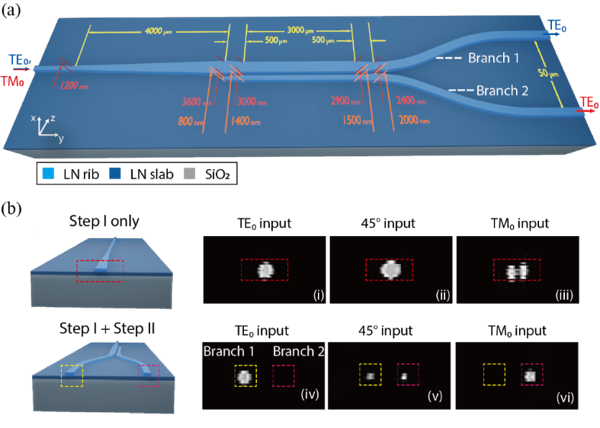Polarization state of light is one of the most important degrees of freedom for information encoding. Devices that can effectively perform tasks such as polarization rotation and polarization splitting are crucial components for both classical and quantum optical communication systems. In photonic integrated circuits, polarization manipulation devices are also important for processing input optical signals that do not have a pure polarization state.
Polarization rotator-splitter is a promising solution to address such problems, which makes use of a compact configuration to accomplish two polarization operation tasks at once, namely polarization rotation and polarization separation. To date, polarization rotator-splitters have been implemented in many popular integrated photonic platforms, including silicon, silicon nitride, and indium phosphide, among others.
In recent years, devices based on thin-film lithium-niobate-on-insulator (LNOI) platforms have been developing rapidly. Many high-performance photonics devices have been demonstrated, including high-speed electro-optic modulators, high-efficiency wavelength converters, broadband frequency comb sources, and entangled photon-pair generators.
However, most research works on LNOI-based polarization manipulation devices are still at the theoretical stage. Realization of a broadband polarization rotator-splitter on the LNOI platform could greatly expand the LNOI photonics toolbox and provide effective solutions for polarization-encoded classical communication systems and quantum photonics in the future.
The research group led by Dr. Cheng Wang from City University of Hong Kong has experimentally demonstrated a broadband adiabatic polarization rotator-splitter based on the lithium niobate on insulator platform. The research results are published in Photonics Research, Volume 9, Issue 12, 2021 (Zhaoxi Chen, Jingwei Yang, Wing-Han Wong, Edwin Yue-Bun Pun, and Cheng Wang, "Broadband adiabatic polarization rotator-splitter based on a lithium niobate on insulator platform," Photon. Res. 9, 2319-2324 (2021)).
This polarization rotator-splitter can separate the two input modes, namely fundamental transverse electric (TE0) and fundamental transverse magnetic (TM0) mode, and project them into the two output ports respectively, both in TE0 mode (Fig. 1a). Importantly, the output polarizations are both aligned with the optical axis of the lithium niobate crystal, which can effectively utilize the largest electro-optic and second-order nonlinear optic coefficients, therefore is highly compatible with other functional devices in LNOI.
Experimental results show that the device exhibits excellent polarization beam splitting capability in the telecommunication band, with relatively low polarization crosstalk of ~ -10 dB (Fig. 1b). The working bandwidth covers the entire telecom C and L bands and majority of the S band, limited only by the testing laser. According to numerical simulation, the device potentially exhibits an ultra-wide bandwidth of more than 500 nm. Moreover, the device fabrication process, waveguide structure and dimensions, crystal orientation and input/output optical modes are all highly compatible with other high-performance photonic devices reported in the LNOI platform.
"The excellent compatibility with other LNOI devices," says Dr. Cheng Wang, "could readily allow further integration of this polarization rotator-splitter with active components such as high-speed electro-optic modulators, enabling dual-polarization integrated photonic transmitter systems and polarization-encoded quantum information processing systems on the LNOI platform."

Fig. (a) Schematic of the polarization rotator-splitter (PRS), where TE0 and TM0 input modes are separated and output from Branch 1 and Branch 2 respectively, both in TE0 mode. (b) Infrared camera images of the output mode profiles for different input polarization states.


